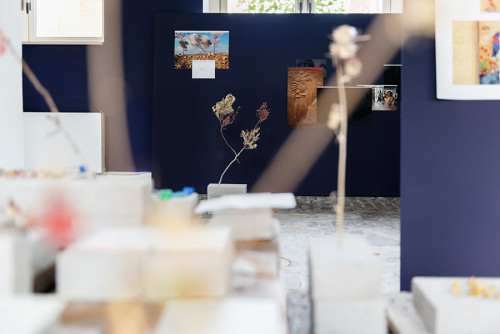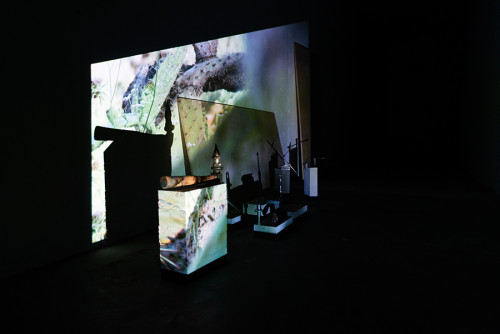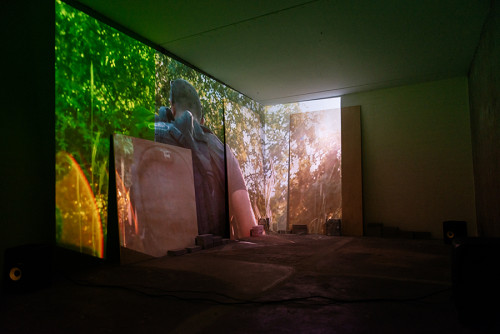
Exhibition view, we know what it is for, we who have used it, 2018. Photo: LNDW Studio.
We know what it is for, we who have used it
BASEL ABBAS & RUANNE ABOU-RAHME
September 9 – November 4, 2018
The exhibition We know what it is for, we who have used it emerges from the long-term research project And yet my mask is powerful by Palestinian artist-duo Basel Abbas and Ruanne Abou-Rahme. For this project they returned to the sites of Palestinian villages in Israel that were emptied and destroyed in 1948. Following the faint traces of the past, the artists developed a reversed museology as a strategy to breathe new life into these places. Through the sampling of myths, images, texts, sounds and artifacts from different era’s, the artists draw the contours of a parallel or even a-historical time that is not occupied: a counter-mythology as an alternative to the dominant, often colonial narratives with which we describe our present.
At the heart of Abbas and Abou-Rahmes’ project lie a collection of 9000-year old Neolithic masks, which were excavated from different areas in the West Bank. The objects have been withdrawn from the public eye after being acquired by private collections. The artists ‘hacked’ the masks by secretly photographing them when they were once on public display in the Israel Museum. With these photographs, they reproduced them using 3D-printing technology. Abbas and Abou-Rahme wield these archeological finds—which predate monotheistic religions and the current political conflicts of the region area—as prosthetics through which to re-examine or re-imagine the past, and to offer new ways to understand history and a sense of time and place in the Middle East; consciously moving away from the media’s focus on endless crisis and violence in the region.
PART I
And yet my mask is powerful.
The exhibition We know what it is for, we who have used it has three parts. Part I is a video and sound installation. The camera follows a group of young people on a trip to their ancestral home, which leads them to the site of the destroyed Palestinian village. We see them uncover and wear the 3D printed masks which were found in that very same land. The masks allow them to become ‘other’, to become anonymous and dive into a world where they are not meant to be. The artists have taken Adrienne Rich’s feminist poem Diving into the Wreck (1971–72)—from which the project and exhibition draw their titles—as a script, framing the young people’s rituals and movements that bring new live into the abandoned village. Transposed into English and Arabic, the text forgoes metaphors—seeking not the story of the wreck, but the wreck itself—and searches for what can possibly be retrieved from such a disastrous site. Rich’s feminist screed describes a solitary figure who draws on existing structures, yet embarks alone toward a society without domination. Abbas and Abou-Rahme repurpose her words to question colonial legacies and occupation.
PART II
And yet my mask is powerful.
The second part of the exhibition resembles a scholarly study of museum storage, encompassing both prehistoric time and a digital future. The installation unfolds the artists’ multi-layered, associative research process. Printed images, notes and fragments of scientific studies overlap with one another against a deep blue background, while masks are unpacked in the midst of a living herbarium of plant specimens. Abbas and Abou-Rahme sourced this vegetation from the destroyed villages of their research. Yet the signs of the old vegetation, such as a small cacti, the traces of wild asparagus or a lone pomegranate tree, lead you back to the remains. Every spring the contours of the villages rise like phoenixes from its ashes when the vegetation blooms again.
PART III
We know what it is for, we who have used it
In the third part of the exhibition the masks again play a lead role. Abbas and Abou-Rahme gave the masks a voice by writing texts which shift between thinking about the genealogy of the mask and the ways in which artifacts can not only be freed from historic collections, but can also be activated as living matter again. The texts take on the form of stories which think through this process of transforming the mask from fossil, into a live material, as a return to living time.
Support
We know what it is for, we who have used it is supported by the Municipality of Rotterdam, Mondriaan Fonds, VSB Fonds, Stichting ter Bevordering van Volkskracht, and Art Jameel. Public program curated in collaboration with Karima Boudou.

Exhibition view, We know what it is for, we who have used it, 2018. Photo: LNDW Studio.

Exhibition view, We know what it is for, we who have used it, 2018. Photo: LNDW Studio.

Exhibition view, We know what it is for, we who have used it, 2018. Photo: LNDW Studio.

Exhibition view, We know what it is for, we who have used it, 2018. Photo: LNDW Studio.

Exhibition view, We know what it is for, we who have used it, 2018. Photo: LNDW Studio.

Exhibition view, We know what it is for, we who have used it, 2018. Photo: LNDW Studio.

Exhibition view, We know what it is for, we who have used it, 2018. Photo: LNDW Studio.